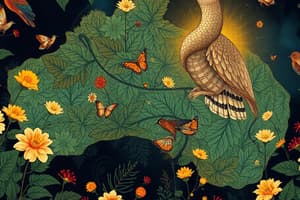Podcast
Questions and Answers
What is the approximate length of Australia's coastline?
What is the approximate length of Australia's coastline?
- 20,000 km
- 25,000 km (correct)
- 10,000 km
- 15,000 km
In which hemisphere is Australia located?
In which hemisphere is Australia located?
- Eastern Hemisphere
- Western Hemisphere
- Southern Hemisphere (correct)
- Northern Hemisphere
Who was the first European to land in Australia?
Who was the first European to land in Australia?
- James Cook
- Willem Janszoon (correct)
- Abel Tasman
- Captain Arthur Phillip
What is the approximate percentage of the population born overseas?
What is the approximate percentage of the population born overseas?
When did Australia gain independence from the UK?
When did Australia gain independence from the UK?
What is the average life expectancy in Australia?
What is the average life expectancy in Australia?
What is the percentage of indigenous Australians in the population?
What is the percentage of indigenous Australians in the population?
Which of the following is a major industry in Australia?
Which of the following is a major industry in Australia?
Flashcards are hidden until you start studying
Study Notes
Geography and Climate
- Located in the Southern Hemisphere, southeast of Asia
- World's sixth-largest country by total area
- Comprises six states (New South Wales, Victoria, Queensland, South Australia, Western Australia, and Tasmania) and two territories (Australian Capital Territory and Northern Territory)
- Coastline stretches for over 25,000 km
- Diverse climate, ranging from tropical in the north to temperate in the south and desert in the center
History
- Indigenous Aboriginal and Torres Strait Islander peoples inhabited the continent for at least 65,000 years before European settlement
- Dutch explorer Willem Janszoon landed in Cape York Peninsula in 1606, marking the first European discovery
- British established the first penal colony in 1788, leading to the displacement and marginalization of indigenous populations
- Gold rushes and immigration in the mid-19th century drove population growth and economic development
- Australia gained independence from the UK in 1901, becoming a federal state
Economy
- Strong service-based economy, with a high GDP per capita
- Major industries include mining, agriculture, and tourism
- Trade relationships with China, the US, Japan, and South Korea are significant
- Member of the Asia-Pacific Economic Cooperation (APEC) and the G20
Culture
- Multicultural society, with over 30% of the population born overseas
- Strong cultural influences from British, Irish, and Asian immigration
- Vibrant arts scene, with renowned institutions like the Sydney Opera House and the National Gallery of Australia
- Popular sports include cricket, rugby, and Australian Rules football
Demographics
- Population of approximately 25 million people
- Highest population densities in the eastern states, particularly in Sydney and Melbourne
- Average life expectancy is over 82 years, one of the highest in the world
- Indigenous Australians make up around 3% of the population
Geography and Climate
- Located in the Southern Hemisphere, southeast of Asia
- World's sixth-largest country by total area
- Comprises six states and two territories
- Coastline stretches for over 25,000 km
- Tropical climate in the north, temperate in the south, and desert in the center
History
- Indigenous Aboriginal and Torres Strait Islander peoples inhabited the continent for at least 65,000 years
- First European discovery by Dutch explorer Willem Janszoon in 1606
- British established the first penal colony in 1788, leading to indigenous displacement and marginalization
- Gold rushes and immigration in the mid-19th century drove population growth and economic development
- Australia gained independence from the UK in 1901, becoming a federal state
Economy
- Strong service-based economy with high GDP per capita
- Major industries: mining, agriculture, and tourism
- Significant trade relationships with China, the US, Japan, and South Korea
- Member of APEC and the G20
Culture
- Multicultural society with over 30% of the population born overseas
- Strong cultural influences from British, Irish, and Asian immigration
- Vibrant arts scene with renowned institutions like the Sydney Opera House and the National Gallery of Australia
- Popular sports: cricket, rugby, and Australian Rules football
Demographics
- Population of approximately 25 million people
- Highest population densities in the eastern states, particularly in Sydney and Melbourne
- Average life expectancy: over 82 years, one of the highest in the world
- Indigenous Australians make up around 3% of the population
Studying That Suits You
Use AI to generate personalized quizzes and flashcards to suit your learning preferences.




